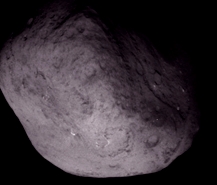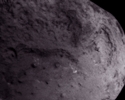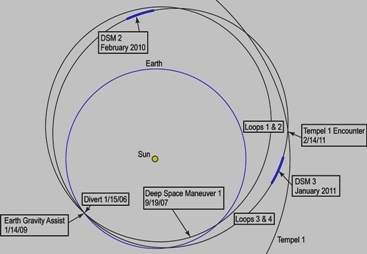
- - text and links as of last publication - -
 | A General View of Comet Tempel 1 as Seen by the Stardust-NExT Mission on February 14th, 2011. picture courtesy of site 'Amateur Astronomy' based on a picture NASA/JPL-Caltech/Cornell |
NASA's Stardust-NExT mission successfully encountered the Tempel 1 comet on February 14th, by 8:40 p.m. PST (11:40 p.m. EST), at a distance of approximately 111 miles (178 km)! The Stardust-NExT mission was a transformation of the Stardust mission, a NASA's mission which had launched by early 1999 and had successfully passed close to comet Wild 2 in January 2004, collecting cometary dust as it eventually came by Earth to release a sample-ladden capsule in January 2006. NASA then, since the summer of 2007 had extended the craft mission under the name Stardust-NExT, to a second flyby of comet Tempel 1, by Feb. 14, 2011, while is was to be returning from a close approach to the Sun and as the comet had been the object of the Deep Impact mission in 2005 which had had a load impacting at the surface. After that passage at Tempel 1, the Stardust craft should keep imaging until no longer of value and eventually be plugged off by March or April 2011. Comet 9P/Tempel is a periodic comet discovered by Wilhelm Tempel on April 3, 1867 orbit of which lies between the orbits of Mars and Jupiter as it belongs to the Jupiter-family comets, which are comets orbital periods are varying because of close approaches with the planet Jupiter. Comet Tempel 1 nucleus is elongated and irregular, with a size 4.7-3 miles (7.6-4.9 kilometer) and its rotation period of about 41.9 hours. Pictures from the Deep Impact impact are showing that the nucleus is featuring several regions of distinct morphology, suggesting considerable variation in exposed materials, geologic processes and ages. Dozen apparently circular features, ranging from 131 to 1,312 feet (40 to 400m) are extant. Whether such features are impact craters or sublimation pits remains uncertain. Smooth surface regions were also spotted and located in gravitational lows, reminiscent of the plateau seen on comet Borrelly, but the surroundings are different. There is circumstantial evidence that the smooth deposits may be associated with either recent or currently active regions on the nucleus
 | Animated Sequence of Stardust-NExT Mission at Comet Tempel 1 on February 14th, 2011. Comet's Nucleus at Closest is by 111 Miles (178 km) Away Only!. animation courtesy of site 'Amateur Astronomy' based on pictures NASA/JPL-Caltech/Cornell |
As the mission proceded with trajectory correction maneuvers to focus the target better, it eventually was running by about 24,000 mph (38,600 km/h) during its approach to comet Tempel 1. During the encounter phase, the spacecraft carried out many operations in short order as that was done automatically, the spacecraft being too far away, on the other side of the Sun relative to the Earth, to receive timely updates from Earth. That included turning the spacecraft to point its protective shields between it and the anticipated direction from which cometary particles would approach. Then, 4 minutes to closest, the craft began science imaging of the comet's nucleus. The mission memory was limited to 72 high-resolution images taken through a imaging sequence running for about 8 minutes. The imaging was most closely spaced around the time of closest approach for best-resolution coverage of Tempel 1's nucleus. Spacecraft's navigation camera took the job as it was a amalgam of spare flight-ready hardware left over from previous NASA missions, the Voyager, Galileo and Cassini ones. Each image took about 15 minutes to transmit as the craft had turned on its automatic navigation system in preparation to the flyby. Once the flyby performed, beginning by about 10 p.m. PST (1 a.m. EST on Feb. 15), Stardust turned to point its high-gain antenna at Earth and started downlinking data worth 468 kilobytes and images. 10 hours in total were needed to complete the transmission
 | click to Four Views of Comet Tempel 1 During the Flyby by The Stardust-NExT Mission on February 14th, 2011. Two Image at Center are The Closest Approach Images as Taken at 3 Seconds Before and 3 Seconds After the Closest Passage Respectively. picture courtesy of site 'Amateur Astronomy' based on a picture NASA/JPL-Caltech/Cornell |
The Stardust-NExT craft flew by another angle the Deep Impact had, allowing for more territories seen on the nucleus. It also had like a mission to study the coma, or comet's atmosphere. Engineering telemetry downlinked after closest approach indicates the spacecraft flew through waves of disintegrating cometary particles, including a dozen impacts that penetrated more than one layer of its protective shielding. Instead of having a little stream of uniform particles coming out, debris apparently came out in chunks and crumbled
 |  | click to First Picture (Left) is Showing A Before-and-After Comparison of The Part of Comet Tempel 1 that Was hit By the NASA's Deep Impact Spacecraft Impactor as The Left-Hand Image was Obtained by Deep Impact in 2005 and The Right-Hand Image Showing Arrows Identifying the Rim of the Deep Impact Impactor Crater, as Second Picture (Right) is A Other Before-and-After Comparison of The Part of Comet Tempel 1 that Was hit By the NASA's Deep Impact Spacecraft Impactor Showing, in Succession, From Left to Right the Impact Area Before Impact, as Highlighted with a Red Circle, the Area After Impact (With a Indication of Sunlight Incidence and Selected Features), and The Accurate Spot of The Impact. White Arrow is The Impactor's Trajectory. picture courtesy of site 'Amateur Astronomy' based on a picture NASA/JPL-Caltech/University of Maryland/Cornell (left) and on a picture NASA/JPL-Caltech/Cornell/Univ. of Maryland (right) |
On the side of the nucleus of comet Tempel 1 the flyby revealed territories that had never been seen before. Three terraces of different elevations are visible, with dark, banded scarps, or slopes, separating them. The widest of the banded slopes is about 1 miles (2 km). The lowest terrace has two circular features that are about 500 ft (150 m) in diameter. Such configuration likely hint to layers coating the nucleus, a observation Deep Impact already had done for the other side of the comet. Pictures released also allow to check changes in the surface of comet Tempel 1 which likely might be due to that, between the two visits, the comet made one trip around the Sun. Changes are caused by a erosion with is caused by volatile substances evaporating away from the comet. In a region highlighted with a smooth terrain at a higher elevation than the more textured surface around it, with prominent white cliffs showing the limit, the cliffs have been seen eroded by as much as 66 to 100 ft (20 to 30m) in some places as depressions have merged together over time, also from erosion. White cliffs or deposits are also seen on other images taken during the flyby which likely are related to the cometary nucleus activity when exposed to Sun's heat. As far as the scar of the 2005 Deep Impact mission's collision with Tempel 1 is concerned, it is also worth the science as images returned are showing a crater with a small, brighter mound in the center as some of the ejecta likely went up and came right back down. On how subdued the crater looks like, scientists think that that cometary nucleus is fragile and weak. The impact crater is estimated to be 500 ft (150 m) wide
 |  | click to Terraces Seen At Comet Tempel 1 by the Stardust-NExT Mission, With a Spatial Resolution of About 50 ft (15 m) per pixel (left) and to Terrain Changes at Comet Tempel 1 Between the Deep Impact Mission in 2005 and the Stardust-NExT Mission in 2011. Smooth Terrain at a Higher Elevation Than Textured Surface Aside as Cliffs Eroded Back to The Left or Other Changes Seen Too (right). pictures courtesy of site 'Amateur Astronomy' based on a picture NASA/JPL-Caltech/Cornell (left) and NASA/JPL-Caltech/University of Maryland/Cornell (right) |
 | A Illustration of The Stardust-NExT Mission Trajectory. picture site 'Amateur Astronomy based on a picture NASA |
The trajectory of the Stardust-NExT mission, like illustrated by image above, consisted of four loops of the Sun in two separate orbits. Loops 1 and 2 represent the orbit the spacecraft like was left in after the sample return on Jan. 15, 2006. The Earth gravity assist on Jan. 14, 2009 placed the spacecraft in the final heliocentric orbit (Loops 3 and 4) intercepting Tempel 1 on Feb. 14, 2011 (39 days after the comet’s perihelion)
The Stardust-NExT Mission was featuring a certain number of phases like described below
| encounter-minus-16 hours | any final modifications or refinements to the existing flyby commands are uploaded. This is the final scheduled two-way communications with the spacecraft until after encounter |
| encounter-minus-3 hours | the spacecraft turns on the Comet and Interstellar Dust Analyzer instrument |
| encounter-minus-1 hour | the Encounter Phase enters its "critical sequence." This sequence is characterized by the spacecraft carrying out many important milestones. The first milestone of this sequence occurs at encounter-minus-one hour, when the spacecraft turns to place its protective Whipple Shields in the ram direction -- that is the spacecraft puts its shields between it and the anticipated direction cometary particles would approach. This maneuver places the spacecraft in an attitude that does not allow the high-gain antenna to point at Earth. As a result, there will not be any high-rate communications between the spacecraft and ground during this critical phase |
| encounter-minus-30 minutes | the spacecraft initiatesits AutoNav program. AutoNav allows the onboard navigation system to assist camera pointing by adjusting the angle of the NavCam's scan mirror. It also provides information to the spacecraft's attitude system on the magnitude of a roll that the spacecraft performs at five minutes before closest approach. The role is designed to correct any out-of-plane error and thus keep the comet's nucleus in the camera's field of view |
| encounter-minus-20 minutes | the Dust Flux Monitor instrument is turned on |
| encounter-minus-5 minutes | the spacecraft initiates a "roll-to-comet point." This approximately 40-second long rolling maneuver places the spacecraft in an attitude that optimizes the NavCam's ability to keep Tempel 1's nucleus in its field of view |
| encounter-minus-4 minutes | the science imaging begins. The nominal imaging sequence runs from encounter-minus-4 minutes to encounter-plus-4 minutes. The spacecraft's onboard memory is limited to 72 high-resolution images, so the fastest possible NavCam imaging frequency is used around closest approach for best-resolution coverage. From encounter-minus-4 minutes to encounter-minus-2 minutes-and-24 seconds, 12 frames are taken (one every 8 seconds). From encounter-minus-2-minutes-and-24 seconds to encounter-plus-2-minutes-and-30 seconds, 48 frames are taken (one every 6 seconds). From encounter-plus-2-minutes-and-38 seconds to encounter-plus-3-minutes-and-50-seconds, 12 frames are taken (one every 8 seconds) |
| encounter! | the spacecraft is expected to be approximately 200 kilometers (124 miles) from the comet's nucleus |
| encounter-plus-1-minute-and-36-seconds | AutoNav has completed operations and is turned off |
| encounter-plus-4 minutes | high-resolution science imaging is complete |
| encounter-plus-20 minutes | the Dust Flux Monitor instrument is turned off |
| encounter-plus-60 minutes | the spacecraft performs an attitude change to point its high-gain antenna at Earth |
| encounter-plus-3 hours | the Comet and Interstellar Dust Analyzer instrument is turned off. This completes the collection of science data during the Encounter Phase of the Tempel 1 flyby. A total of 720 megabytes of data, including 72 high-resolution images, are stored for playback |
| encounter-plus-3-hours-and-38-minutes | the Madrid dish of NASA's Deep Space Network begins to receive the playback of science data collected during encounter. Five selected NavCam images are returned first. NExT, data from the two other instruments are downlinked. Finally, the remaining 67 high-resolution images taken during encounter are downlinked. To ensure all images and science instruments data have been collected, the science data from encounter will be downlinked in its entirety up to three times during the NExT two days |